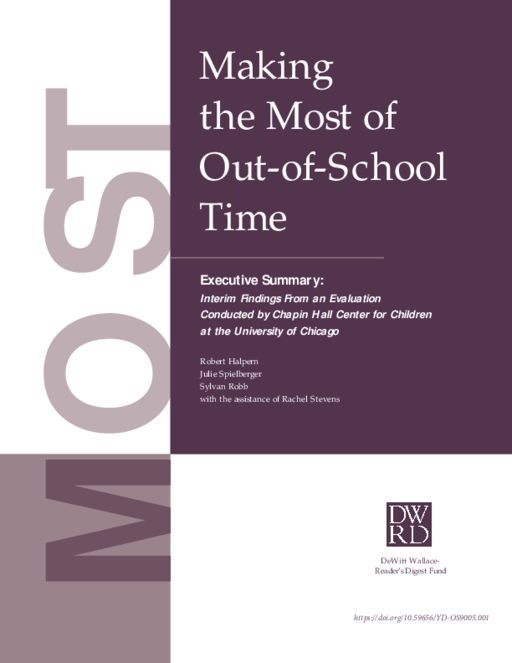- Author(s)
- Robert Halpern, Jullie Spielberger, and Sylvan Robb
- Publisher(s)
- The National Institute on Out-of-School Time at the Wellesley Centers for Women
Research Approach
Through staff interviews, observation of programs, and analysis of quantitative data, researchers at the Chapin Hall Center for Children at the University of Chicago conducted an evaluation of MOST.
The purposes of the evaluation were to:
- Describe the attributes/characteristics of the school-age care system in each city
- Describe and assess the collaborative structures and new inter-institutional relationships created through MOST in each city
- Analyze the supply of school-age care in each city and document MOST’s contribution to it, focusing especially on low-income children and underserved populations
- Describe and assess the effectiveness of the MOST strategies in each city
- Reflect on the overall MOST strategy, including its goals
Researchers translated these objectives into a set of research questions that guided data collection.
Methods for Gathering Data
The evaluation team relied on a variety of methods to secure the necessary data:
Interviews with MOST staff, staff of school-age care programs and intermediary organizations in each city, and staff of the National Institute on Out-of-School Time (NIOST)
Observation of MOST committees; observations of school-age care programs
Collection of existing quantitative data in each of the three cities
Collection of reports and other documents from the MOST lead agencies and school-age care programs
Mini-Studies
This interim report consists of three separate mini-studies, each pertaining to a central mission of the MOST Initiative. The first is a report of efforts to develop and test a methodology for ascertaining the supply of school-age care in each city. The second is a report on NIOST’s effort to pilot the Assessing School-Age Quality (ASQ) assessment in each of the MOST cities. The third is an effort to address the question of what might be meant by the school-age care system; to describe the characteristics of school-age care systems in each city; and to discuss each city’s system-building efforts.
Chapin Hall began its evaluation work in the spring of 1997, well into the second year of the initiative. Data was then collected through the summer of 1998 and was analyzed during the 1998-99 school year. A final report was prepared during the summer of 1999.

